Zalakdozi uses concentric rings to fill a pattern. There are a lot many styles in which a pattern can be filled, like using various shades of the same color for the various rings. I have used darker shades to do the outline and lighted and paler shades to fill the inside. The only time a concentric ring is not used is when there is no space to go roundabout and allows you a journey of chain stitch only one way.
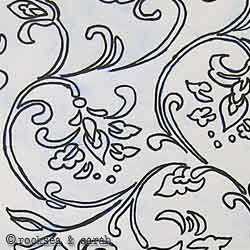 | 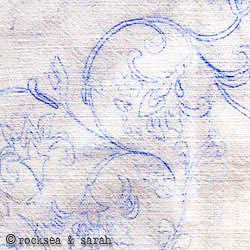 |
| Fig 1: First, I traced out a floral design onto a linen cloth, using carbon paper. | |
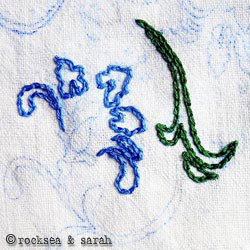 | Fig 2: Start by doing the outline using the Chain Stitch. I have used deeper colors for the outlining. |
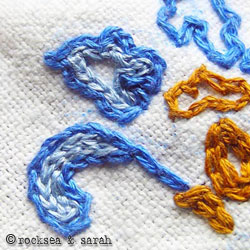 | Fig 3: Once the outline is done, I start to fill in the inside using a paler or lighter colors/shades. The filling is done in concentric rings following the shape of the motif. Do not leave any visible space between each ring. At the same time, do not make it too tightly packed. The chain stitch must lay relaxed to give it a ‘Zalakdozi’ effect. |
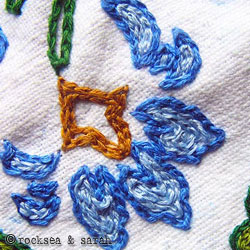 | Fig 4: While some parts of the pattern get filled with just one ring of the paler color, some others might require more rings to get filled. Some patterns might require just a single Lazy Daisy stitch to get filled. |
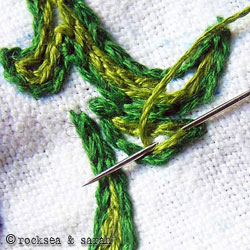 | Fig 5: The Zig-Zag Chain stitch can be used to make sharp turns while filling a motif. |
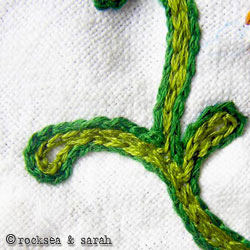 | Fig 6: Some parts of the pattern might be left with spaces in the center. You can either leave the spaces or fill it in. Here, I chose to leave in the space. |
 | Fig 7: It is not always necessary to use a concentric ring(s) to fill a pattern. If you see the illustration, you will see that some patterns can be filled with chain stitch done just one way, as there is no room for a return stitch. |
 | Fig 8: While stitching, you might encounter places where you get ‘bottlenecked’, as in the illustration. I stitched one way and while turning around to stitch my way back, I encountered a ‘bottleneck’, marked between A and B. This is an area where I cannot accommodate another stitch. In such a case, I end the journey at A and come up again at B to resume the journey. |
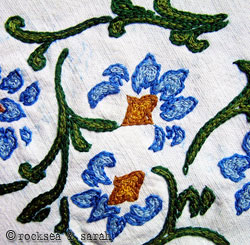 |  |
| Fig 9/10: The close-up and whole finished design using Zalakdozi. | |
Do you want to know more about Zalakdozi – its origin, history, and other details? Click below.









Salam everyone! How are you sarah? Can you please tell me how many kinds of sari work? Is this stitch has a family like other stitches or a single stitch?????
Aari work. Not sari work
Lovely and easy to follow explanation. Thanks
Glad you liked them, Lulu. ,☺️
Hi mam …
So nice your embroidery stitches your web is very useful in beginners. I am daily watching ur website and learning embroidery thank u so much I love it
You dont knw how much pleasure you have given me by replying.
Thanx a ton.
To tel you the truth, I think I hav done a good job
But the credit goes to you
Coz I learnt it 4m here.
Dear Sarah,
Here is my zalakdozi work. I would lyk your opinion on it.
DO REPLY
Did I mention I absolutely adore your tutorial?
Dear Koyel,
It is absolutely great! I think you have done a beautiful work. AM happy to see it.
What do you think of your own work?
Thanks for sharing this…I wanted to see someone who had followed and used Zalakdozi.
Hi,
Very good mam,
And this is a very good service to society
May GOD bless you.
Vijayalakshmi Pothiraj
Hi sarah,
I am very glad to see this website. Its very useful n u have explained it very nicely. Thanks sarah thsnks a lot
This is so pretty!!! 🙂 Thankyou for sharing!! 🙂 Awesome idea!!
woah!!! 🙂 I am working on piillow cases these days… I had an imagination to use letters on my stitch with some creepers over it…
I had no idea how I was gonna do it… I was about to paint them instead of stitch…
I guess this might help me out… i’l try….
thank you so much
hey sarah, the information you have provided is worth it..
your website has really helped me a lot..i have 2-3 questions in my mind, would be pleased if you answer them..
Is zalakdozi/ aari work and kashida are same or have different meanings?
Whats the exact meaning of “Zalak” and “dozi”?
Which place in kashmir is famous for this art and where all it is marketed?
i would be glad if you help me with these questions.. Thanks a lot..
keep doing the great work..
Dear Jyoti,
Please read through this for information : https://www.embroidery.rocksea.org/hand-embroidery/zalakdozi/
As per my knowledge, kashida means ’embroidery’ , so some casually called like that too.
how can i join your site i tried
Where do you find the patterns/designs? Do you also design them or have a ready to use pattern?
Hi Sarah,
I like your stitches very much , they are so much user friendly. I was actually finding a embroidery website for my friend who was learning it and while doing that found your website and found such easy explanations that i thought even i can do it easily . From then i have started learning the stitches and just love to see the outcome.. they are beautiful… thank you for your hardwork and making the things simple for us.
Deepa.
Hi,
I am so glad to come across this site. Its amazing and I am so excited to try this out. Do we have instructions with complete design and how to fill it up?
Thanks a ton.
Hi sarah,
i new to hand embroidery…
i want to do Embroidery on my top ,but i am not getting any neck patterns for my Kurtis…
could you help me on this issue ….
hi sarah you are 2 good
I have an idea to work for a stitched dress. Where can i get the neck design for my kids dress size? So that i can start the embroidery. Suggest me your ideas. Thanks for your help in advance.
Thanks
Madumathi
Hi sarah
do u teach gold spring work? ( i dnt no d real name of work, may b zardosy) 🙂
Thank u very much!!!
i was looking for such a tutorial from many days. i learn’t a lot from your tutorial,thanks a ton. Hope I will succeed in this. In case if I have doubts, can I send you a mail.
Dear Lakshmi,
Thanks. 🙂
If you have any doubts, you can just post a comment. I will receive it in my email box and can reply to you. This will help other readers to clear similar doubts too.
hai sarah i like your works
i have small interest in hand embroidery but i have no time .anyway congratulations
dear sarah,
Your work and this website is really great and the way you have presented everything here makes it so easy for people like me(who do not know anything about hand embroidery but are willing to learn it) to learn hand embroidery without even spending a single penny 😀
you are doing great.
Thanks 🙂
Hi Sarah,
I found your site very appealing and informative.
I have used many of your stitches for my work.
Could you provide me a tutorial for Jali Work used in Chikan Embroidery?
Thanks
Anindita
Dear Anindita,
I am yet to prepare tutorials for chikan work. I am hoping to do so some time soon, so, please bear with the time taken. 🙂
Dear Sarah
thank you so much for giving us this wonderful and very very useful site. I spent almost 2000 to 2500 rupees to learn basic stitches.. After that only I came to know about ur site.. it is so useful for me to refresh my stitches.. I am interested in learning Kantha and Kasuthi.. Do u have any plans of posting or publishing a book in that .. I would love to buy a book if u are going to publish…. let us know and keep up the good work.. Prayers and wishes for your work..
theresa
Dear Theresa,
🙂 Thanks.
If you want tutorials on Kasuti, you can check this link: https://www.embroidery.rocksea.org/hand-embroidery/kasuti/
We are working on a book, so will let you know once it is out.
I want to learn aari embroidery. Can you suggest some websites to learn from the basics
Dear Sasi,
To learn aari work, you need the tools. This website might help you to learn the art, if you have the tools : artisticfingers.blogspot.in/search/label/Aari%20embroidery
My tutorial helps you to do aari work (or replicate it) with the help of simple embroidery needle. It is more work, but you can do it without the need of big tools.